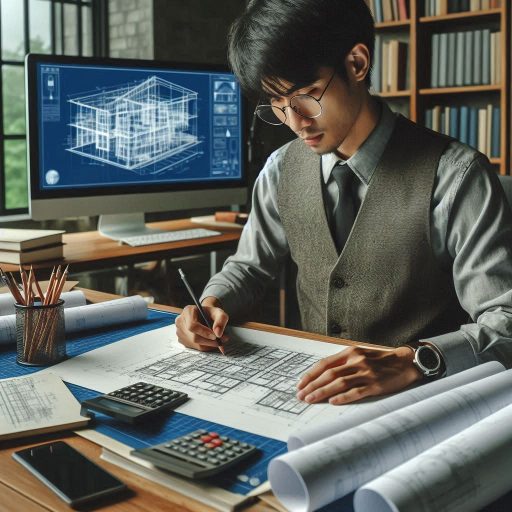Introduction
Overview of What a Drafter Does
A drafter creates detailed technical drawings and plans used in construction, manufacturing, and engineering projects.
They transform concepts and specifications into precise visual representations.
Drafters use advanced software and drafting tools to produce accurate and comprehensive diagrams.
Their work supports engineers, architects, and builders by providing clear instructions and specifications for project execution.
By interpreting and drafting plans, drafters play a crucial role in ensuring that projects adhere to design specifications and standards.
Importance of Having Essential Skills for a Successful Drafter Career
Essential skills are fundamental for a successful drafter career.
Precision and accuracy are critical for creating reliable and functional designs.
Proficiency with drafting software and a solid understanding of engineering principles enable drafters to produce high-quality work.
Effective communication skills are also crucial for collaborating with engineers and architects, ensuring that all design details are clearly conveyed.
Developing these skills enhances job performance and opens doors to advanced career opportunities.
Mastering these essential skills is key to building a successful and rewarding career in drafting.
Technical Drawing Skills
Importance of Being Proficient in Technical Drawing Software
Proficiency in technical drawing software is essential for a successful drafter career.
Mastery of software like AutoCAD or SolidWorks enables drafters to create precise, detailed drawings.
These tools help convert design concepts into actionable plans.
Without strong software skills, creating accurate and professional drawings becomes challenging.
Understanding Different Types of Drawings (2D, 3D, Schematics, etc.)
Drafters must understand and utilize different types of drawings.
2D drawings provide a flat view, essential for initial designs and layout plans.
3D drawings offer a detailed perspective, showing depth and spatial relationships.
Schematics, which represent electrical or mechanical systems, are crucial for understanding complex systems.
Diagrams simplify and illustrate functional relationships, aiding in communication and design clarity.
Ability to Interpret and Create Accurate Technical Drawings
The ability to interpret and create accurate technical drawings is fundamental.
Drafters must understand and apply various symbols, notations, and scales.
Accurate interpretations ensure that designs meet specifications and function as intended.
Creating precise drawings prevents errors, saving time and reducing costs.
This skill is vital for maintaining quality and achieving successful project outcomes.
In summary, technical drawing skills are critical for a drafter’s career.
Proficiency in software, understanding various drawing types, and the ability to create and interpret accurate drawings are all essential for success.
Mastering these skills ensures effective design and project execution.
Read: Tips for Writing Environmental Engineering Reports
Attention to Detail
The Importance of Precision in Drafting
In drafting, precision is a cornerstone of success.
Accurate measurements and dimensions are critical for creating reliable and effective drawings.
Precision in drafting ensures that every detail aligns with the intended design, avoiding costly errors and delays.
Drafts with precise details are essential for the overall quality of engineering projects.
Mistakes in dimensions can lead to significant problems, including structural issues and project setbacks.
Therefore, emphasizing precision helps maintain the integrity and functionality of the final product.
Accurate drafts not only reflect the drafter’s skill but also contribute to the smooth execution of projects.
This emphasis on precision supports effective communication among engineers, clients, and other stakeholders, ensuring that everyone is aligned and informed.
Checking and Double-Checking Dimensions and Measurements
Drafters must adopt a rigorous approach to checking and double-checking every dimension and measurement.
This practice is crucial for preventing significant issues that can arise from even minor errors.
The use of precise tools, such as calipers and digital measuring instruments, is essential for achieving accurate results.
Each dimension and measurement should be carefully verified to ensure correctness.
Regular and thorough reviews of drafts help identify and correct mistakes before they impact the project.
Fresh eyes and peer reviews are valuable in catching errors that may be overlooked.
Double-checking dimensions helps avoid miscommunication between engineers and clients, ensuring that structures are built as intended.
This meticulous approach to verification contributes to the overall quality and success of the project.
Being Meticulous in Creating Drawings to Minimize Errors
Meticulous attention to detail is crucial for minimizing errors in drafting.
Drafters should approach each drawing with a high level of precision, ensuring that every detail is accurately represented.
Adopting a routine for thorough checking and using high-quality drafting tools are essential practices.
Digital drafting tools also require careful handling to maintain accuracy in input settings.
Meticulous work not only reflects the drafter’s professionalism but also supports the success of the project.
Each detail in a drawing contributes to its effectiveness, and any oversight can lead to errors and complications.
By being diligent and thorough, drafters can prevent issues and ensure that their work meets the highest standards of quality.
In summary, attention to detail is a fundamental skill for successful drafting.
Emphasizing precision, regularly checking and double-checking dimensions, and being meticulous in creating drawings are key practices that ensure accuracy and minimize errors.
Effective drafters consistently apply these principles, resulting in high-quality drafts and successful project outcomes.
Maintaining these high standards is crucial for achieving excellence in drafting and supporting the overall success of engineering projects.
Knowledge of Industry Standards
Understanding and Following Industry-Specific Guidelines and Standards
A solid grasp of industry-specific guidelines and standards is crucial for drafters.
These standards dictate the format, symbols, and conventions used in technical drawings.
For instance, architectural drawings follow different conventions than engineering diagrams.
Understanding and adhering to these guidelines ensure that drawings are accurate, consistent, and meet industry expectations.
This adherence prevents misinterpretations and ensures that the drawings effectively communicate design intentions.
Mastery of these standards is fundamental for maintaining professionalism and quality in every project.
Keeping Up-to-Date with Changes in Standards and Regulations
Staying current with changes in standards and regulations is essential for drafters.
Industry standards are not static; they evolve with advancements in technology, materials, and practices.
Regularly reviewing updates to standards helps ensure that drawings remain compliant with the latest requirements.
For example, changes in safety regulations or material specifications can impact how drawings should be prepared.
Being informed about these changes helps drafters avoid errors related to outdated practices and ensures that their work remains relevant and effective.
Ensuring That Drawings Meet All Necessary Requirements
Ensuring that drawings meet all necessary requirements is a critical responsibility for drafters.
This involves verifying that all drawings adhere to project specifications, industry standards, and regulatory requirements.
For example, a construction drawing must comply with local building codes and zoning laws.
Accurate and compliant drawings prevent misunderstandings and errors in the final product, reducing the risk of costly revisions.
Drafters must meticulously check their work to ensure it meets all outlined criteria, contributing to the project’s success and overall quality.
In summary, a strong knowledge of industry standards is vital for drafters.
Understanding and following specific guidelines ensures that drawings are accurate and professional.
Keeping up-to-date with changes in standards and regulations helps maintain the relevance and compliance of the work.
Additionally, ensuring that all drawings meet necessary requirements is essential for preventing errors and achieving project success.
Mastering these aspects not only ensures high-quality, professional drawings but also supports effective communication and successful project outcomes.
Read: Environmental Engineering and Marine Conservation
Communication Skills
Collaborating Effectively with Engineers, Architects, and Other Team Members
Effective collaboration with engineers, architects, and other team members is crucial in drafting.
Drafters must work closely with these professionals to ensure that all design requirements are accurately translated into technical drawings.
Clear communication and teamwork help resolve design issues, align goals, and integrate various perspectives.
Building strong working relationships facilitates smoother project execution and fosters a collaborative environment, which ultimately contributes to the success of the project.
Clearly Articulating Design Ideas and Concepts Through Drawings
The ability to clearly articulate design ideas and concepts through drawings is essential.
Drafters must create detailed and accurate visual representations that convey complex design intentions.
Clear and precise drawings help team members understand the design and its functionality.
Effective visual communication ensures that all parties are on the same page and can make informed decisions based on the drafter’s work.
Transform Your Career Today
Unlock a personalized career strategy that drives real results. Get tailored advice and a roadmap designed just for you.
Start NowAbility to Give and Receive Constructive Feedback
The ability to give and receive constructive feedback is vital for professional growth and project success.
Drafters should provide clear, actionable feedback to colleagues to enhance the quality of their work.
Similarly, being open to receiving feedback helps drafters refine their skills and improve their drawings.
Constructive feedback fosters a culture of continuous improvement and collaboration, leading to better design outcomes and more efficient project completion.
In summary, strong communication skills are integral to a drafter’s success.
Collaborating effectively with engineers, architects, and team members ensures that all design aspects are properly addressed.
Clearly articulating design ideas through detailed drawings facilitates understanding and decision-making.
Additionally, the ability to give and receive constructive feedback supports professional development and enhances the overall quality of work.
Mastering these communication skills ensures smooth project execution and successful outcomes.
Read: How to Stay Updated in Environmental Engineering Field

Problem-Solving Skills
Identifying and Resolving Design Issues in Drawings
Problem-solving skills are vital for addressing design issues in technical drawings.
Drafters must be adept at identifying discrepancies, errors, or inconsistencies in their work.
This requires a keen eye for detail and an understanding of design principles.
Once issues are identified, drafters must resolve them effectively to ensure that the final drawings are accurate and functional.
This process often involves reworking elements of the design and making necessary adjustments to meet project specifications.
Thinking Creatively to Find Solutions to Complex Design Problems
Creative thinking is essential for solving complex design problems.
Drafters must approach challenges with an innovative mindset to develop effective solutions.
This might involve reimagining design elements or employing unconventional methods to overcome obstacles.
Creative problem-solving helps in finding efficient and practical solutions that meet both aesthetic and functional requirements.
It also allows drafters to tackle unique or unexpected issues that arise during the design process.
Ability to Adapt and Make Changes Based on Feedback
Adaptability is crucial for incorporating feedback and making necessary changes.
Drafters must be open to revising their work based on input from team members or clients.
This flexibility ensures that the final drawings align with project goals and requirements.
Being able to adjust designs quickly and effectively in response to feedback helps maintain project momentum and addresses any concerns or improvements suggested by stakeholders.
In summary, strong problem-solving skills are essential for drafters.
Identifying and resolving design issues, thinking creatively to address complex problems, and adapting to feedback all contribute to successful drafting outcomes.
Mastering these skills ensures that designs are accurate, innovative, and responsive to evolving project needs.
Read: Essential Skills for CAD Technicians
Time Management Skills
Handling Multiple Projects and Deadlines Efficiently
Effective time management is crucial for handling multiple projects and deadlines.
Drafters often juggle several tasks simultaneously, each with its own timeline.
Efficiently managing these responsibilities involves organizing and scheduling work to ensure timely completion.
Using tools like project management software or planners helps track progress and meet deadlines.
Balancing multiple projects without compromising quality requires strong organizational skills and the ability to prioritize effectively.
Prioritizing Tasks Based on Urgency and Importance
Prioritizing tasks based on urgency and importance is essential for efficient time management.
Drafters must assess which tasks need immediate attention and which can be addressed later.
This involves distinguishing between high-priority tasks, such as urgent revisions, and lower-priority ones, like routine updates.
Prioritizing effectively ensures that critical tasks are completed on time and that overall project goals are met.
Avoiding Delays in the Drafting Process
Avoiding delays in the drafting process is key to maintaining project timelines.
To prevent setbacks, drafters should adhere to their schedules and proactively address potential issues.
This includes managing time effectively, avoiding procrastination, and promptly addressing any obstacles that arise.
Regular progress reviews and adjustments help keep the drafting process on track, ensuring that deadlines are met and projects are completed as planned.
In summary, strong time management skills are essential for drafters.
Handling multiple projects and deadlines efficiently, prioritizing tasks based on urgency and importance, and avoiding delays are all critical practices.
Mastering these skills ensures that projects are completed on time and to a high standard, contributing to overall success in the drafter’s career.
Understanding of Manufacturing Processes
Knowledge of How Designs Translate into Physical Products
Understanding how designs translate into physical products is vital for drafters.
This knowledge ensures that technical drawings are practical and feasible.
Drafters must comprehend how design elements will be constructed or assembled, which impacts the final product’s functionality.
For instance, knowing the dimensions and tolerances required for manufacturing helps avoid design flaws that could lead to production issues.
This understanding ensures that designs are not only visually appealing but also viable for production.
Considering Factors Like Material Choice, Manufacturing Methods, and Cost Efficiency
Considering factors such as material choice, manufacturing methods, and cost efficiency is crucial.
The selection of materials affects the durability and performance of the final product.
Drafters must choose materials that meet the design requirements and are suitable for the intended use.
Understanding various manufacturing methods, such as CNC machining, injection molding, or 3D printing, is essential for designing components that can be produced effectively.
Each method has its own set of capabilities and limitations, which should influence the design process.
Additionally, cost efficiency is a key consideration.
Designing with cost in mind helps ensure that the project remains within budget while maintaining quality and functionality.
Collaborating with Manufacturing Teams to Ensure Feasibility of Designs
Collaborating with manufacturing teams is vital for ensuring the feasibility of designs.
Drafters must engage with these teams to understand their capabilities and limitations.
Effective communication helps identify potential issues early in the design process.
For example, if a design feature is too complex or costly to produce, feedback from manufacturing teams can lead to necessary adjustments.
This collaboration helps refine designs to ensure they can be produced as intended, avoiding costly revisions and delays.
Engaging with manufacturing teams ensures that designs are not only innovative but also practical and achievable within the constraints of production.
In summary, a thorough understanding of manufacturing processes is essential for drafters.
Knowing how designs translate into physical products ensures that drawings are practical and feasible.
Considering material choices, manufacturing methods, and cost efficiency helps create designs that are both effective and economical.
Collaboration with manufacturing teams ensures that designs are feasible and can be produced successfully.
Mastering these aspects ensures that technical drawings lead to high-quality, successful outcomes in the manufacturing process.
Conclusion
The Importance of Essential Skills for a Successful Drafter Career
Essential skills are crucial for a successful drafter career.
Precision, technical knowledge, and creativity are fundamental.
Mastering drafting software and understanding engineering principles distinguish top drafters from others.
Effective communication ensures clear collaboration with engineers and architects, making these skills indispensable.
Encouragement for Aspiring Drafters to Focus on Developing These Skills
Aspiring drafters should commit to developing these essential skills.
Continuous learning and hands-on practice will significantly enhance expertise and career prospects.
Pursue education and training opportunities to stay ahead in the field.
Building a strong foundation in drafting principles and software is key to advancing in this career.
Transform Your LinkedIn into a Job Magnet
Picture recruiters reaching out to you daily. We craft personalized LinkedIn profiles that stand out, boosting your visibility in ways others can't. Elevate your career now.
Upgrade NowThe Rewarding Nature of a Career in Drafting for Those Who Are Dedicated to Honing Their Craft
A career in drafting is rewarding for those dedicated to honing their craft.
Transforming abstract concepts into detailed, practical designs provides immense satisfaction.
The ability to see one’s designs come to life and contribute to significant projects is fulfilling.
Embrace the journey with dedication, and enjoy the professional growth and satisfaction that follow.




